Abstract
OBJECTIVE--To examine the possibility that subclinical damage may persist after clinical recovery from neurological decompression illness. METHODS--The neuraxes of 71 divers with medical histories of neurological decompression illness and 37 non-diver controls were examined by recording the somatosensory evoked potentials produced on stimulation of the posterior tibial and median nerves. RESULTS--Although the tests gave some objective support for the presence of "soft" residual neurological symptoms and signs, no evidence was given for the presence of subclinical damage. CONCLUSIONS--The contention that neurological damage persists after full clinical recovery from the neurological decompression illness was not supported.
Full text
PDF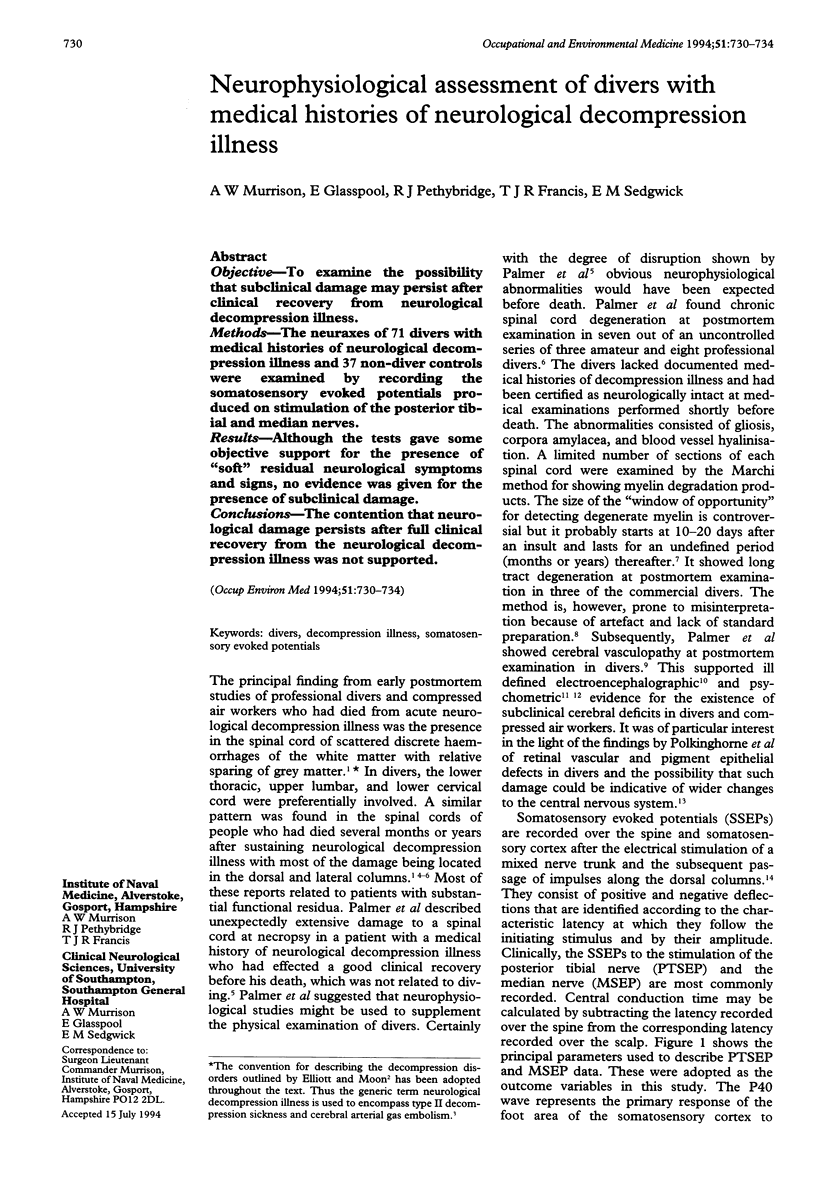
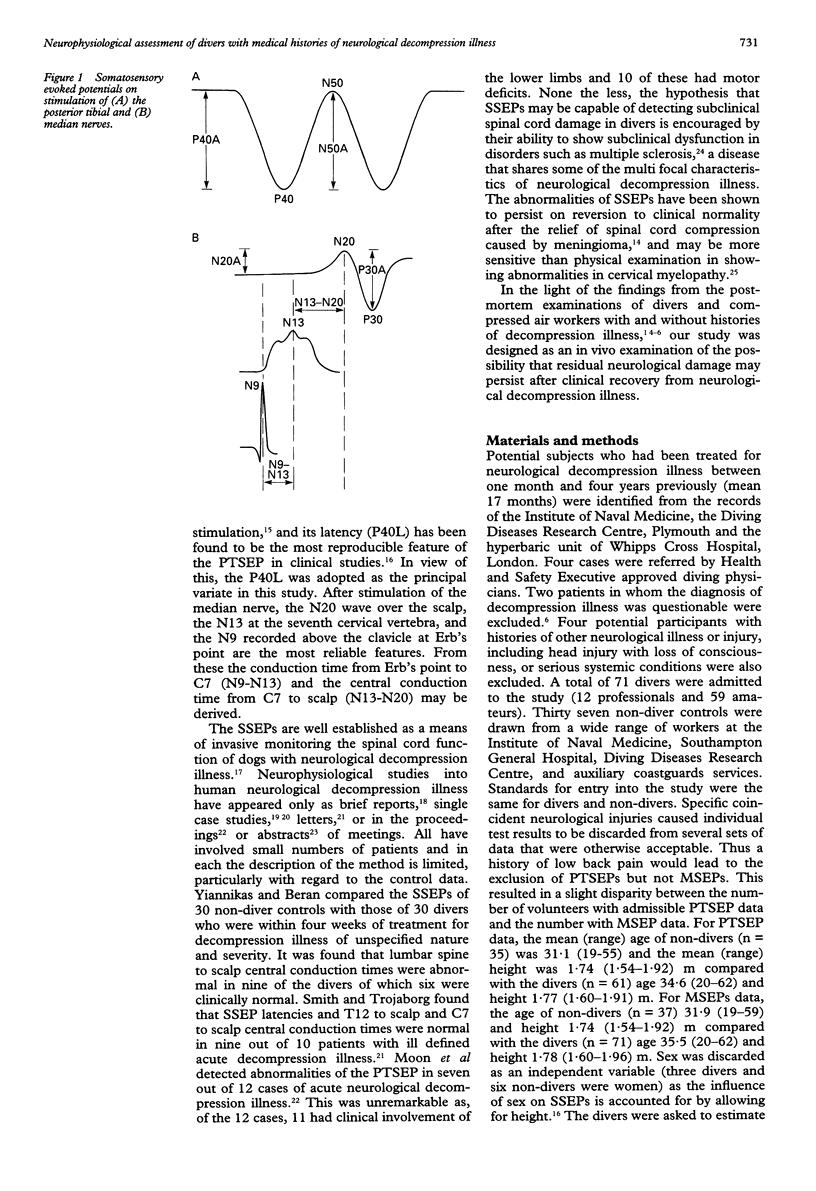
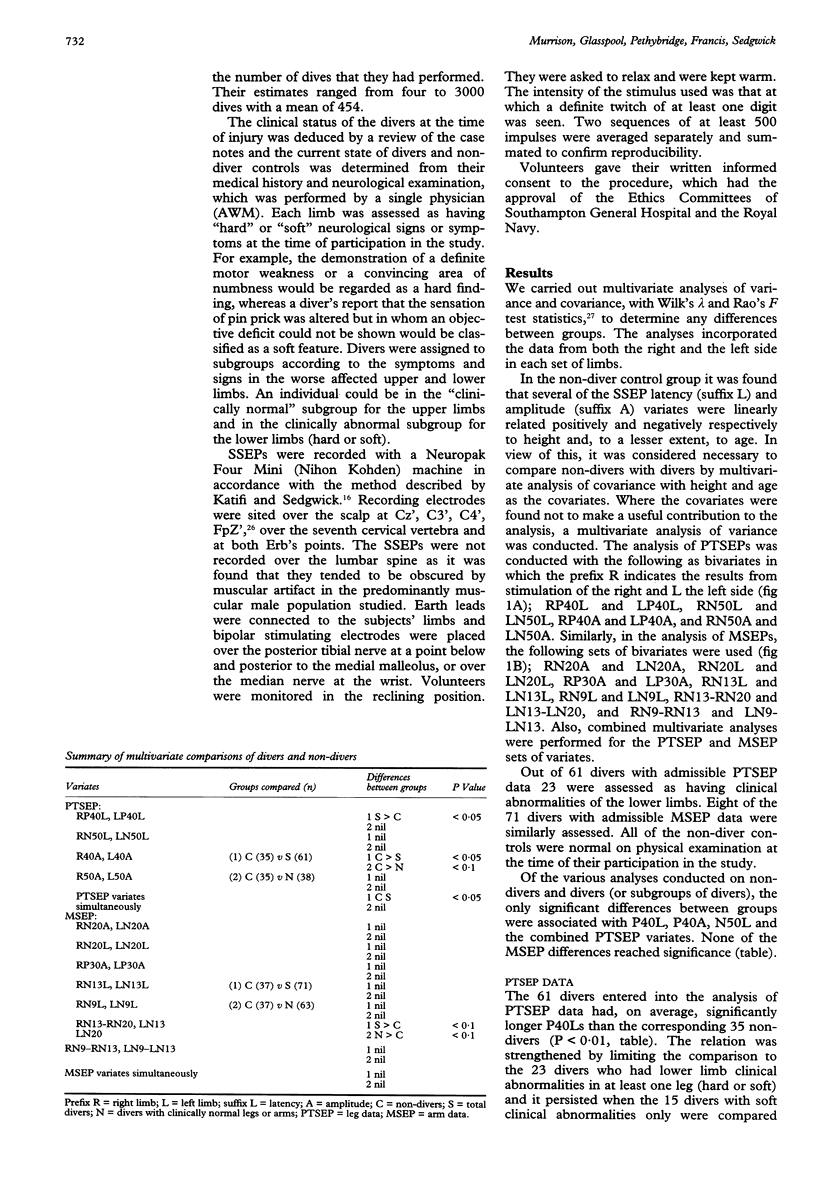
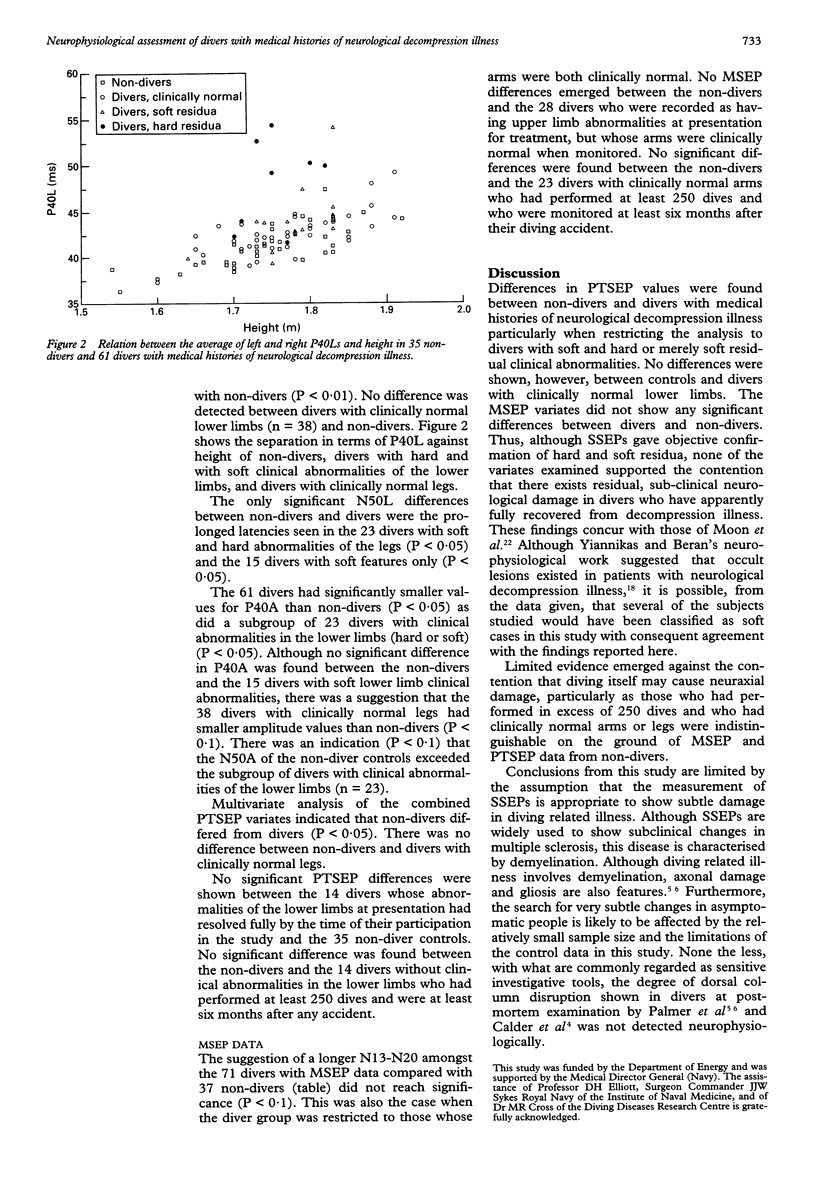
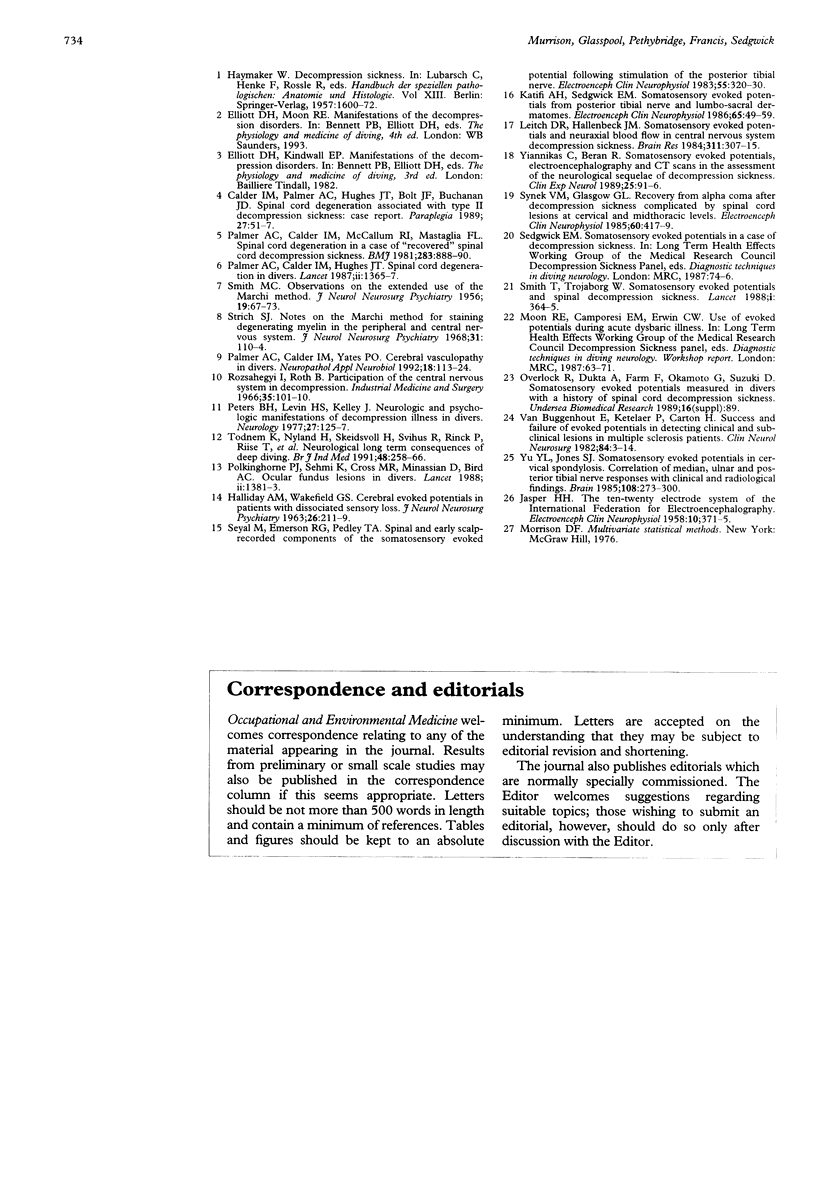
Selected References
These references are in PubMed. This may not be the complete list of references from this article.
- Calder I. M., Palmer A. C., Hughes J. T., Bolt J. F., Buchanan J. D. Spinal cord degeneration associated with type II decompression sickness: case report. Paraplegia. 1989 Feb;27(1):51–57. doi: 10.1038/sc.1989.8. [DOI] [PubMed] [Google Scholar]
- HALLIDAY A. M., WAKEFIELD G. S. Cerebral evoked potentials in patients with dissociated sensory loss. J Neurol Neurosurg Psychiatry. 1963 Jun;26:211–219. doi: 10.1136/jnnp.26.3.211. [DOI] [PMC free article] [PubMed] [Google Scholar]
- Leitch D. R., Hallenbeck J. M. Somatosensory evoked potentials and neuraxial blood flow in central nervous system decompression sickness. Brain Res. 1984 Oct 8;311(2):307–315. doi: 10.1016/0006-8993(84)90093-3. [DOI] [PubMed] [Google Scholar]
- Palmer A. C., Calder I. M., Hughes J. T. Spinal cord degeneration in divers. Lancet. 1987 Dec 12;2(8572):1365–1366. doi: 10.1016/s0140-6736(87)91259-1. [DOI] [PubMed] [Google Scholar]
- Palmer A. C., Calder I. M., McCallum R. I., Mastaglia F. L. Spinal cord degeneration in a case of "recovered" spinal decompression sickness. Br Med J (Clin Res Ed) 1981 Oct 3;283(6296):888–888. doi: 10.1136/bmj.283.6296.888. [DOI] [PMC free article] [PubMed] [Google Scholar]
- Palmer A. C., Calder I. M., Yates P. O. Cerebral vasculopathy in divers. Neuropathol Appl Neurobiol. 1992 Apr;18(2):113–124. doi: 10.1111/j.1365-2990.1992.tb00773.x. [DOI] [PubMed] [Google Scholar]
- Peters B. H., Levin H. S., Kelly P. J. Neurologic and psychologic manifestations of decompression illness in divers. Neurology. 1977 Feb;27(2):125–127. doi: 10.1212/wnl.27.2.125. [DOI] [PubMed] [Google Scholar]
- Polkinghorne P. J., Sehmi K., Cross M. R., Minassian D., Bird A. C. Ocular fundus lesions in divers. Lancet. 1988 Dec 17;2(8625):1381–1383. doi: 10.1016/s0140-6736(88)90583-1. [DOI] [PubMed] [Google Scholar]
- Rozsahegyi I., Roth B. Participation of the central nervous system in decompression. Ind Med Surg. 1966 Feb;35(2):101–110. [PubMed] [Google Scholar]
- SMITH M. C. Observations on the extended use of the Marchi method. J Neurol Neurosurg Psychiatry. 1956 May;19(2):67–73. doi: 10.1136/jnnp.19.2.67. [DOI] [PMC free article] [PubMed] [Google Scholar]
- Seyal M., Emerson R. G., Pedley T. A. Spinal and early scalp-recorded components of the somatosensory evoked potential following stimulation of the posterior tibial nerve. Electroencephalogr Clin Neurophysiol. 1983 Mar;55(3):320–330. doi: 10.1016/0013-4694(83)90210-9. [DOI] [PubMed] [Google Scholar]
- Smith T., Trojaborg W. Somatosensory evoked potentials and spinal decompression sickness. Lancet. 1988 Feb 13;1(8581):364–365. doi: 10.1016/s0140-6736(88)91166-x. [DOI] [PubMed] [Google Scholar]
- Strich S. J. Notes on the Marchi method for staining degenerating myelin in the peripheral and central nervous system. J Neurol Neurosurg Psychiatry. 1968 Apr;31(2):110–114. doi: 10.1136/jnnp.31.2.110. [DOI] [PMC free article] [PubMed] [Google Scholar]
- Synek V. M., Glasgow G. L. Recovery from alpha coma after decompression sickness complicated by spinal cord lesions at cervical and midthoracic levels. Electroencephalogr Clin Neurophysiol. 1985 May;60(5):417–419. doi: 10.1016/0013-4694(85)91015-6. [DOI] [PubMed] [Google Scholar]
- Todnem K., Nyland H., Skeidsvoll H., Svihus R., Rinck P., Kambestad B. K., Riise T., Aarli J. A. Neurological long term consequences of deep diving. Br J Ind Med. 1991 Apr;48(4):258–266. doi: 10.1136/oem.48.4.258. [DOI] [PMC free article] [PubMed] [Google Scholar]
- Yiannikas C., Beran R. Somatosensory evoked potentials, electroencephalography and CT scans in the assessment of the neurological sequelae of decompression sickness. Clin Exp Neurol. 1988;25:91–96. [PubMed] [Google Scholar]
- Yu Y. L., Jones S. J. Somatosensory evoked potentials in cervical spondylosis. Correlation of median, ulnar and posterior tibial nerve responses with clinical and radiological findings. Brain. 1985 Jun;108(Pt 2):273–300. doi: 10.1093/brain/108.2.273. [DOI] [PubMed] [Google Scholar]
- van Buggenhout E., Ketelaer P., Carton H. Success and failure of evoked potentials in detecting clinical and subclinical lesions in multiple sclerosis patients. Clin Neurol Neurosurg. 1982;84(1):3–14. doi: 10.1016/0303-8467(82)90105-6. [DOI] [PubMed] [Google Scholar]


